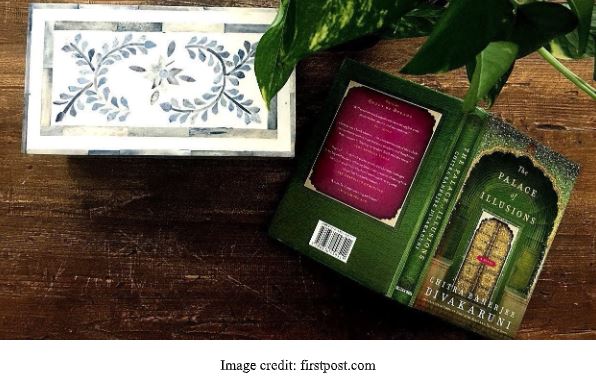The Mahabharat, one of the longest epic poems in the world containing over 100,000 Shloaks 200,000 verses, with about 1.8 million words, believed to have been written over the course of 600 long years and set at the end of the Dvapar Yug or the Third Age of Men. Most of us have heard fragments of the story at our home, watched the T.V and film adaptations or read long chapters in textbooks. We were mystified and entranced by the magic, the politics, the intersecting lives of Gods and men, the myriad of stories within stories, the various protagonists and antagonists, their psychology and but of all the family rivalry that led to the biggest war of all time.
Vyas composed the poem glorifying the men, explaining their complexities, their motives but what of the women? They remained as shadows lurking on the pages only to serve the men, to be exploited for gain and to bear the consequences of their actions. Kunti, the widowed mother of the Pandavas giving her all to raise her five children; Gandhari, the queen of Hastinapur, but rarely mentioned as, sacrificing her vision for her husband’s sake, and Panchaali, the women berated by all, painted to be the one who caused the terrible fate. It is she; Chitra Banerjee Divakaruni gives voice to through the pages of her Palace of Illusions.
She writes in the Author’s note “If I ever wrote a book, I would place the women in the forefront of the action. I would have one of them tell it herself, with all her joys and doubts, her struggles and triumph, her heartbreaks, her achievements, the unique female way in which she sees the world and her place in it.” And she did exactly that.
Image credit: duexpress.in
The Palace of Illusions is narrated by Draupadi or Panchaali as she is later called. It takes the reader through the various phases of her life. From her life at her father’s palace, where she resents herself for being unwanted and longs to set into motion what has been prophesised at her birth, to change the course of history, to her life changing swayamwar and her unconventional marriage to five men, from her dissatisfaction at this to making this arrangement work and becoming the brothers’ counsel in her own palace of illusions, to being gambled away as a bag of coins, humiliated as the greatest heroes of the time watch, to the war where she would lose more than she could gain and to her last walk.
Image credit: artstation.com
What strikes from the beginning of the book is how relatable Draupadi’s thoughts and feelings come across as. Her constant questioning of events, rules, and conversations gives a dimension to her character. Her ever so analyzing thoughts provoke the readers mind to think about her decisions, which the author has written with bold imagination. It portrays the vulnerabilities and flaws of an enigmatic woman and humanizes her from the pages of an epic to just a woman struggling to find her way, her voice in a heavily patriarchal world. Through her inner conversations the author sketches a visible and wonderful transition in Paanchali’s maturity, her decision making and her becoming a queen of the ages from a young rebellious princess.
At the same time the novel can also come across as repetitive and monotonous with similar thoughts playing on Draupadi’s mind and her long monologues about even the simplest of days.
The dynamics of her relationship with each of the Pandava brothers has been illustrated exemplarily, her changing feelings and opinions towards each gives the reader a dive into their characters. Her feelings towards Karna, Kunti’s eldest and lost son, which even though do not find space in the epic but perhaps can be attributed to creative license, make her out to be a flawed human being making her all the more relatable. What the story lacks is mentions of her relationship with Nakul and Sehdev, the youngest of the Pandavas. It majorly revolves around the eldest three.
The author in naming the beginning and the ending chapters “fire” connects the start and the finish while establishing the circle of life which births all and consumes all and is a great literary tool.
What disappoints is the age-old pitting of woman against woman. Paanchali’s utter resentment towards Kunti, their fierce dislike of each action the other takes and their continuous war for control over the five brothers and the home holds down the stereotypical narrative of the power struggle between mother-in-laws and daughter-in-laws. It came unexpectedly in a narration acclaimed for its feminism.
Image credit: art-ma.com
Overall, it is a read worth spending time with, the story remains the same with no alternative ending but it offers a fresh perspective to a timeless tale. Stories akin to this one need to be brought to light and silenced women be given the much-forsaken voice.

